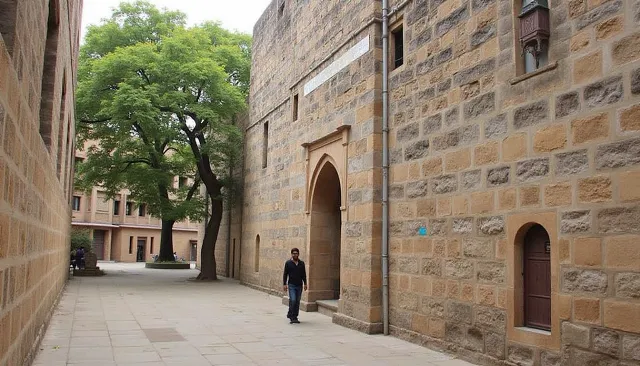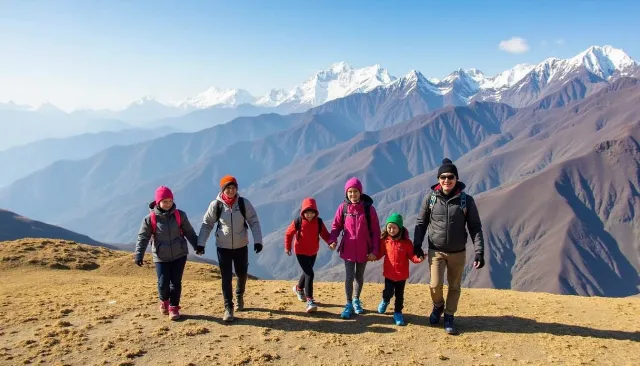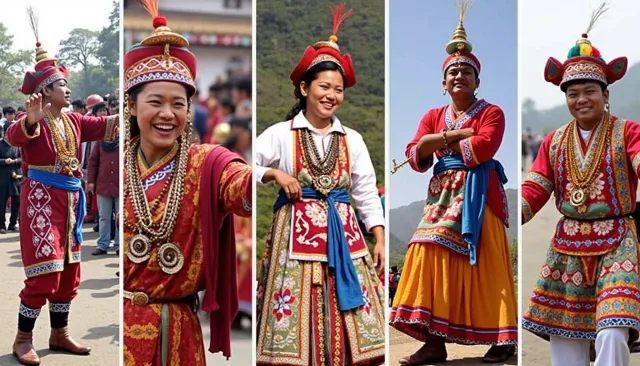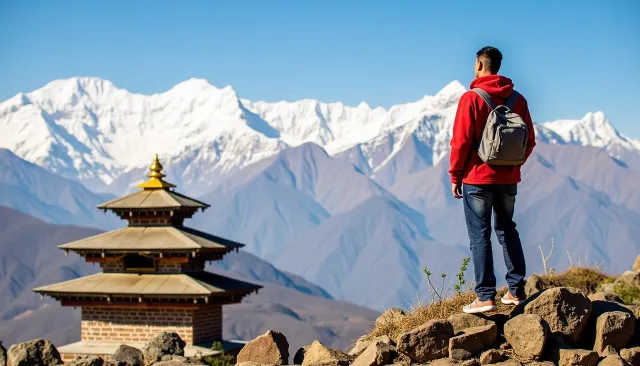1. Introduction to Kathmandu Valley
Kathmandu Valley is the heart of Nepal. It is a beautiful area surrounded by hills and filled with history, culture, and nature. The valley is home to three main cities: Kathmandu, Patan, and Bhaktapur. These cities are full of colorful buildings, temples, and busy markets. People from all over the world visit the valley to see its beauty and learn about its traditions.
The valley is very old. Archaeologists believe people have lived here for thousands of years. You can see old palaces, temples, and streets that tell stories of kings and queens. Every corner of the valley has something interesting to explore. From the lively markets to peaceful temples, there is always something new to discover.
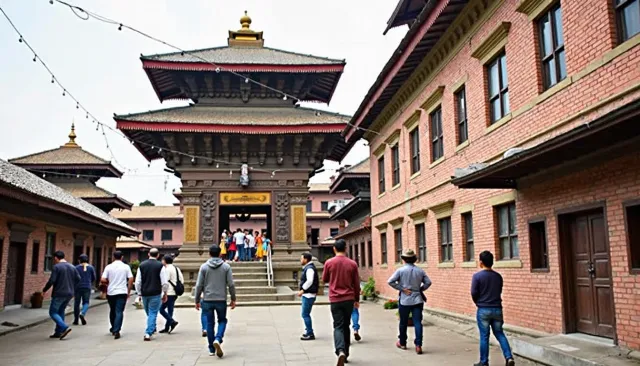
Kathmandu Valley is also famous for its festivals and food. People celebrate with music, dance, and delicious dishes. Visiting the valley is not only about seeing buildings but also about feeling the culture and joy of its people. Whether you like history, art, or tasty food, Kathmandu Valley has something for everyone.
2. The Historical Significance of the Valley
Kathmandu Valley is very important in Nepal’s history. Long ago, it was the center of kingdoms and trade. Kings and queens built palaces, temples, and statues here. Many travelers and traders came to the valley, bringing new ideas and cultures. Because of this, Kathmandu Valley became a mix of many traditions and beliefs.
The valley has many UNESCO World Heritage Sites. These sites are protected because they show the history and art of the past. Places like Durbar Squares, old temples, and stupas tell stories from hundreds of years ago. Each building has carvings, paintings, and designs that are very special.
Learning about Kathmandu Valley’s history helps us understand Nepal today. The traditions, festivals, and ways of life we see now came from the valley’s past. Visiting historical places is like walking back in time. It is fun and exciting, especially for children who love stories about kings, queens, and ancient civilizations.
3. A Glimpse of Newar Culture
The Newars are the original people of Kathmandu Valley. They have lived here for hundreds of years and built many temples, palaces, and markets. Their culture is colorful and full of art, music, and dance. When you visit the valley, you can see Newar culture everywhere, from the houses to the festivals.
Newars are famous for their traditional crafts. They make beautiful wood carvings, pottery, and paintings. Many temples and buildings in the valley were built by Newar artists. During festivals, Newars wear colorful clothes, sing songs, and perform dances that show their rich culture.
Newar food is also special. They make tasty dishes like momo (dumplings), chatamari (rice pancakes), and sweets. Children and adults enjoy these treats during celebrations. Visiting Kathmandu Valley is a great way to see how Newar people live, work, and celebrate life. It is like stepping into a colorful storybook of culture and tradition.
4. Must-Visit Heritage Sites
Kathmandu Valley is full of heritage sites. These are old buildings, temples, and squares that show the history and culture of Nepal. Each site is unique and tells a story about the people who lived here long ago. Visiting them helps you learn while having fun.
Some of the most famous sites are the Durbar Squares in Kathmandu, Patan, and Bhaktapur. These squares have palaces, temples, and statues with amazing carvings. Many festivals happen here, and the streets are always lively. Another important site is the Garden of Dreams, where you can relax and enjoy nature.
Heritage sites are not only beautiful but also educational. Children can see art, history, and culture in one place. Walking around these sites is like a treasure hunt, finding new things to see in every corner. Families visiting Kathmandu Valley can enjoy sightseeing while learning about Nepal’s amazing past.
5. The Ancient Durbar Squares
Durbar Squares are the heart of Kathmandu Valley. “Durbar” means palace, and these squares were the centers of old kingdoms. They have big palaces, temples, and statues. Each square tells stories about kings, queens, and the history of the valley. Kathmandu, Patan, and Bhaktapur each have their own Durbar Square, and all are very special.
The squares are full of art and carvings. You can see wooden windows, stone sculptures, and metal statues of gods and animals. Every detail is carefully made and shows the skill of Newar craftsmen. During festivals, the squares come alive with music, dance, and colorful decorations. It is a fun and exciting place to visit for families.
Visiting Durbar Squares helps children and adults learn about Nepal’s past. Walking through the old streets, you can imagine how life was centuries ago. These squares are not only beautiful but also educational. They show the culture, religion, and traditions of Kathmandu Valley in a lively and colorful way.
6. Famous Temples of Kathmandu
Kathmandu Valley is famous for its temples. People come here from all over the world to visit these holy places. The temples are built to honor gods and goddesses, and each has its own story. Some temples are very old, while others are newer, but all are beautiful and peaceful.
Temples are important in daily life. People go there to pray, light candles, and celebrate festivals. Children can learn about different gods and goddesses while enjoying the colorful decorations. Many temples have amazing carvings, paintings, and statues that show stories from old myths.
Visiting temples is also a chance to experience local traditions. You can see people making offerings, ringing bells, and performing rituals. It is a calm and peaceful experience. Temples in Kathmandu Valley are not just buildings—they are places full of culture, faith, and history that everyone can enjoy.
7. Pashupatinath: The Sacred Shiva Temple
Pashupatinath is one of the most important temples in Nepal. It is dedicated to Lord Shiva, one of the main gods in Hinduism. People come here from Nepal and India to pray and celebrate special festivals. The temple sits on the banks of the Bagmati River, making it very peaceful and scenic.
The temple has golden roofs and beautiful carvings. Only Hindus can go inside the main temple, but visitors can see the building from outside. The river near Pashupatinath is also special. People perform rituals, and you can see colorful prayers and ceremonies along the riverbank.
Visiting Pashupatinath helps you understand Hindu traditions. Children can learn about stories of Lord Shiva, while families enjoy the peaceful surroundings. The temple is lively during festivals, with music, lights, and people praying. Pashupatinath is not just a temple; it is a center of culture, faith, and history in Kathmandu Valley.
8. Boudhanath Stupa: A Center of Tibetan Buddhism
Boudhanath Stupa is one of the largest stupas in Nepal and an important place for Tibetan Buddhists. It has a big white dome and colorful prayer flags that flutter in the wind. Many people come here to walk around the stupa, spin prayer wheels, and pray for peace.
The stupa is very peaceful and spiritual. You can hear monks chanting and see pilgrims from Tibet and other countries. Children can enjoy the colors, the bells, and the calm feeling around the stupa. It is also a great place to take photos and learn about Buddhist traditions.
Boudhanath is more than a building. It represents harmony, culture, and faith. Visiting the stupa teaches respect for different religions and traditions. Families can enjoy walking around, learning stories, and experiencing the calm and beauty of one of Kathmandu Valley’s most famous sites.
9. Swayambhunath (Monkey Temple) Exploration
Swayambhunath, also called the Monkey Temple, is one of the oldest temples in Kathmandu Valley. It is called the Monkey Temple because many monkeys live on the hill where the temple stands. People climb stairs to reach the temple and enjoy a beautiful view of the whole city.
The temple has a golden stupa with the eyes of Buddha painted on it. Pilgrims walk around the stupa clockwise, spinning prayer wheels and praying for peace. Children love watching the monkeys play and hearing the sounds of bells and chants. The area is full of colorful flags and small shrines that make it fun to explore.
Visiting Swayambhunath is a mix of adventure, learning, and spirituality. You can see the city from high above, learn about Buddhist culture, and enjoy the lively temple atmosphere. Families and kids especially enjoy feeding the monkeys and taking pictures. It is a magical place where nature, history, and faith come together.
10. Patan Durbar Square: Art and Architecture
Patan Durbar Square is in the city of Patan and is famous for its beautiful art and architecture. It is one of the three main Durbar Squares in Kathmandu Valley. The square has old palaces, temples, and statues that show the skill of Newar artists from hundreds of years ago.
Every building in Patan Durbar Square has amazing carvings on doors, windows, and walls. The Krishna Mandir is one of the most famous temples here, with stone carvings that tell stories from Hindu mythology. During festivals, the square comes alive with music, dance, and colorful decorations.
Visiting Patan Durbar Square is a great way to learn about Nepal’s culture and history. Children can explore the old streets, see statues of gods, and enjoy the lively atmosphere. It is not only educational but also fun for families who want to experience the beauty of Kathmandu Valley.
11. Bhaktapur: Living Museum of Traditions
Bhaktapur is often called a “living museum” because its old streets and buildings have stayed the same for hundreds of years. The city is famous for its temples, squares, and pottery. Walking around Bhaktapur feels like stepping back in time.
The city has many traditional crafts. You can see people making pottery, weaving, and carving wood. Bhaktapur is also known for its delicious food, like king curd (juju dhau) and local sweets. During festivals, streets are filled with music, dance, and colorful decorations.
Visiting Bhaktapur is a fun way for children and families to learn about culture. You can see old architecture, try traditional food, and watch craftspeople at work. It is a place where history is alive, and every corner has something special to discover in Kathmandu Valley.
12. Festivals and Cultural Events
Kathmandu Valley is full of festivals and cultural events throughout the year. People celebrate with music, dance, and colorful decorations. These festivals are very important in showing the traditions and beliefs of the valley. Children enjoy seeing parades, masks, and performances.
Some famous festivals include Indra Jatra, Dashain, and Tihar. During these celebrations, temples and streets are decorated with lights and flowers. Families gather together, offer prayers, and enjoy traditional food. Festivals are a fun way to experience the culture and joy of Kathmandu Valley.
Cultural events are not only fun but also educational. You can learn about music, dance, and local stories. Children can see traditional clothes, instruments, and customs. Visiting during a festival is a special experience that makes Kathmandu Valley come alive with colors, sounds, and happiness.
13. Traditional Music and Dance in Kathmandu
Kathmandu Valley is full of music and dance. Traditional songs are played during festivals, celebrations, and temple events. People use drums, cymbals, and flutes to make music that is lively and exciting. Children enjoy listening and sometimes even join the dance.
Dance is an important part of the culture. During festivals like Indra Jatra, people wear colorful costumes and masks while performing dances that tell stories from myths and history. These dances show bravery, love, and wisdom, and they are very entertaining to watch.
Learning about music and dance in Kathmandu Valley helps visitors understand the culture. Children can see how stories are shared through movement and rhythm. Families can enjoy performances in squares, streets, or temples, making the experience fun, colorful, and memorable.
14. Kathmandu’s Local Markets
Kathmandu Valley has lively local markets where people sell food, clothes, crafts, and souvenirs. Popular markets include Thamel, Asan, and Indra Chowk. Walking through these markets is an adventure for families, with colorful shops and busy streets to explore.
Markets are a great place to see local life. You can watch people bargaining for goods, try small snacks, and see crafts made by Newar artists. Children love the bright colors, toys, and street performers that make markets exciting.
Visiting Kathmandu’s markets is fun and educational. You can buy handmade crafts, taste traditional foods, and learn about daily life in the valley. The markets are a perfect way to experience the culture, energy, and friendliness of the people of Kathmandu.
15. Traditional Newari Cuisine
Newari food is famous in Kathmandu Valley. Newars are the original inhabitants of the valley, and they have delicious traditional dishes. Popular foods include momo (dumplings), chatamari (rice pancakes), and bara (fried lentil patties). Each dish has a special taste and history.
Food is an important part of festivals and celebrations. Families gather to eat together and share traditional dishes. Street vendors also sell tasty snacks, making it easy to try many foods. Children love the flavors, shapes, and colors of Newari dishes.
Trying Newari cuisine is a fun way to learn about culture. Cooking and eating these dishes connect visitors with local traditions. Families can enjoy tasting different foods while exploring Kathmandu Valley, making the visit delicious and memorable.
16. Street Food Adventures in Thamel
Thamel is a popular area in Kathmandu for tourists and street food lovers. Streets are filled with small stalls selling snacks like pani puri, chat, and fried momos. The smells of spices and fried food make walking around Thamel exciting and fun.
Street food is affordable and tasty. You can try many small dishes in one visit. Children enjoy the colorful food and watching cooks prepare snacks in front of them. Thamel is lively during the day and night, with music and friendly vendors creating a joyful atmosphere.
Visiting Thamel for street food is a great adventure. Families can taste new flavors, explore busy streets, and experience local life. It is a fun way to enjoy the culture of Kathmandu Valley while enjoying delicious and unique foods.
17. Modern Cafés and Fusion Foods
Kathmandu Valley is not only full of traditional food but also modern cafés and fusion restaurants. These places serve coffee, sandwiches, pasta, and cakes along with local snacks. Families and young travelers enjoy visiting cafés to relax after sightseeing.
Fusion foods are very popular here. Chefs mix traditional Nepali flavors with international dishes. For example, momo pizza or Nepali-style burgers are creative dishes you can try. Children often love these fun and tasty experiments. The cafés are decorated with art and music, making them cozy and exciting.
Visiting modern cafés shows a different side of Kathmandu. You can taste both local and international foods, enjoy a comfortable atmosphere, and even meet local artists and travelers. It is a fun and delicious way to enjoy the valley while experiencing its growing food culture.
18. Culinary Workshops and Food Tours
Culinary workshops and food tours are becoming popular in Kathmandu Valley. Visitors can learn how to cook traditional dishes like momo, dal bhat, and Newari sweets. These workshops are fun for families and children because they can participate and see how food is made.
Food tours guide you through markets, street stalls, and cafés. You can taste many dishes while learning their history and ingredients. Local guides share stories about the foods and how they are connected to festivals and traditions. This is a fun way to explore culture through taste.
Joining a food tour or workshop is both educational and exciting. Children can learn cooking skills, try new foods, and understand Nepali culture. Families enjoy spending time together while tasting delicious dishes. It is a memorable way to connect with Kathmandu Valley through its food.
19. Tips for Travelers in Kathmandu Valley
Traveling in Kathmandu Valley is exciting, but it helps to plan ahead. Wear comfortable shoes because many streets are old and uneven. Carry water, snacks, and a small bag for souvenirs when exploring the city.
Respect local customs and traditions. When visiting temples, dress modestly and remove shoes if required. Be polite to people, ask before taking photos, and enjoy festivals with an open heart. Children can learn respect and cultural awareness while traveling.
Plan your visits to include temples, markets, and food experiences. Take your time to explore small alleys and hidden spots. Travel slowly to enjoy the culture, architecture, and food of Kathmandu Valley. With careful planning, your visit will be safe, fun, and unforgettable.
20. Conclusion: Embracing the Heart of Nepal
Kathmandu Valley is a magical place full of history, culture, and food. From ancient temples to lively markets, every corner tells a story. Children and families can explore palaces, squares, and streets while learning about the valley’s rich traditions.
The valley’s festivals, music, and dances create a joyful atmosphere. Traditional and modern foods make visiting even more exciting. Travelers can taste delicious dishes, see colorful celebrations, and enjoy the peaceful temples. Kathmandu Valley combines learning, adventure, and fun for everyone.
Exploring Kathmandu Valley helps visitors understand Nepal’s past and present. It is a place where history, art, and culture come alive. Whether you are walking through an old square, feeding monkeys, or tasting street food, every experience in the valley is special and unforgettable. Kathmandu Valley truly is the heart of Nepal.
